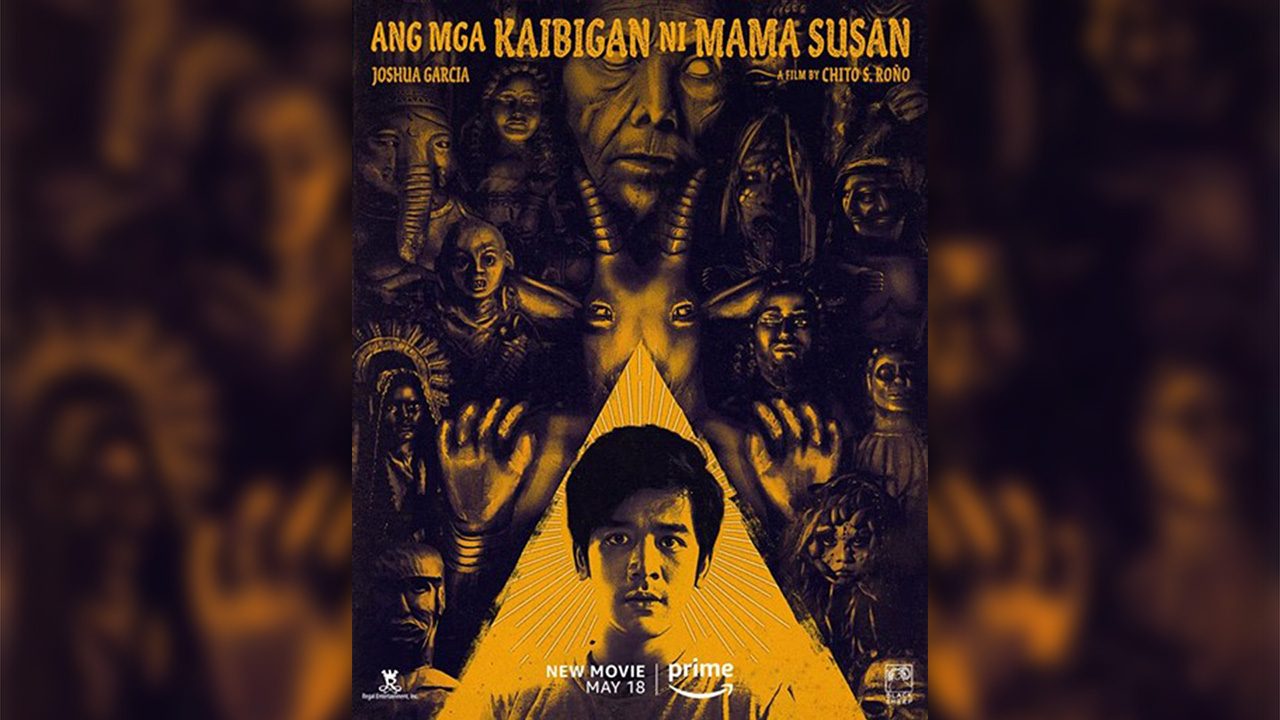SUMMARY
This is AI generated summarization, which may have errors. For context, always refer to the full article.

Spoilers ahead.
When the trailer of Ang Mga Kaibigan ni Mama Susan made rounds online, there were talks that the movie would have made for a far more exciting viewing experience if released on the big screen, its supporters bent on pointing out the density of the source material, especially after many years of waiting for the work to be adapted into film. Yet, post-watching, one could surmise that the decision to sell the movie’s distribution rights to Prime Video was probably for the best, precisely because the work managed to invite attention — one that is buoyed by nostalgia — only for it to blow that opportunity.
Based on the 2010 novel of the same title by Bob Ong, who also wrote the screenplay, the movie tells the story of Galo (Joshua Garcia), a university student who, after a string of unfortunate incidents, returns to San Ildefonso, the town where his grandmother Mama Susan (Angie Ferro) lives. He carries a journal with him, documenting his everyday preoccupations and, more importantly, encounters with the supernatural, until all he writes about turns too real.
Director Chito Roño (Badil, Feng Shui, Dekada ‘70), as if impelled by the need to be faithful to the source text, makes the adaptation an epistolary, and he’s having a field day with this choice, so much so that the movie gathers the urge to slap an image of Galo’s CGI diary over and over again, if not pile details on details that are barely interrogated — Galo’s situation under the care of his aunt Auring (Melissa Mendez), his falling out with Andrea (Sarah Edwards), his apparent involvement in the beating of his friend Roy (Henz Villaraiz), and the death of his father.
All that has transpired in the first act is negligible, for it hardly reveals what purpose the characters within Galo’s proximity serve, apart from mere presence and the necessity to push the story forward, to get to what the movie guarantees to be entrancing, but to little avail. It becomes so obvious that the narrative is clouded by the grandeur of its own mystery that it forgoes a clear sense of direction. Like in the book, Bob Ong reckons that the viewers can fill the gaps, which of course they are more than capable of, only there are too many gaps to fill, exposing the material’s tendency to bite off more than it can actually chew.
It seems to forget that motivation is paramount in the creation of any character in any film, or in any work of art, really. For instance, when Galo begins to link the dots about the peculiar activities of the townspeople who venerate Mama Susan, he’s determined to leave the island for good but later backtracks, and the movie doesn’t bother to explain, or at least nuance, how the character arrives at this decision, given that Galo is supposed to be discerning in the book. Even the mythos that informs the psyche of San Ildefonso is obscured by a thick mist of ambiguity, an aspect that it could have translated into a more refined language to provide the narrative a dimension it badly needs, unless Roño mistakes haze for emotional atmosphere.
And despite the flashes of brilliance in Eli Balce’s camerawork and Jerann Ordinario’s production design, Ang Mga Kaibigan ni Mama Susan’s problem with pace is just too towering to ignore. Editor Carlo Francisco Manatad creates a fiddly push and pull of things: of wanting to go to a specific destination but deciding at the last minute to try a different course; of lingering over sceneries, especially when the shift in setting takes place, to the point that it revels in triteness; of insisting to pursue forgettable plot points that it eventually loses its momentum, like an engine conking out at the most exciting moment of a long road trip.
Whereas many compliment Ferro’s Mama Susan and how she embodies whatever horror the movie is able to achieve, the script positions her character in a way that she cannot have anything much to show. She’s only there when the movie feels the impulse to make the viewers jump in fright, often talking in prophecies and premonitions that cannot be bothered to be interesting, no thanks to how stilted the dialogue is. Had the story afforded the character some more layers and proper development, the final shot would be reaping the overwhelming heights and dramatic intensity that it intends to deliver.
Garcia as the fulcrum of the narrative, however, churns out decent work, trying to make a stronger case not only for his character but also for the lapses in writing. His rapport with child actors Yñigo Delen and Jewel Milag — who played Niko and Jezel, respectively, and whose backstories were only given a limited sketch — drives his performance and offers the movie a bit of texture that, sadly, it refuses to extend to the rest of the characters.
In a Twitter thread, Bob Ong shared that there might be artistic differences between his and Roño’s vision for the material, which probably spells out how the movie feels too fragmented, unable to come up with a lucid message, if not leave a lasting impact.
If there is anything that Ang Mga Kaibigan ni Mama Susan gets right, it’s the point that adopting a written work for the screen, no matter how rich and potent, takes a lot more than being well versed in the original material, highlighting the differences in the medium and space. Without broad imagination and meaningful reading, any adaptation runs the risk of proving its reason for being.
For a movie whose main hook is its reliance on ambiguity for the sake of effect, Ang Mga Kaibigan ni Mama Susan winds up eclipsing what it strives to convey instead of peaking there, uncertain of where to go and stuck in a tight spot of its own creation, like someone in deep need of a friend’s help. – Rappler.com
Ang Mga Kaibigan ni Mama Susan is streaming on Prime Video.
Add a comment
How does this make you feel?

There are no comments yet. Add your comment to start the conversation.